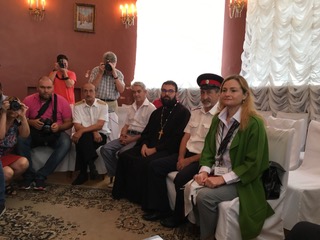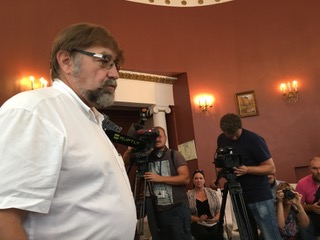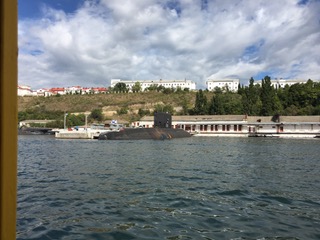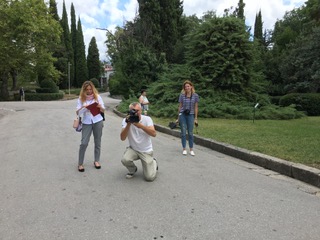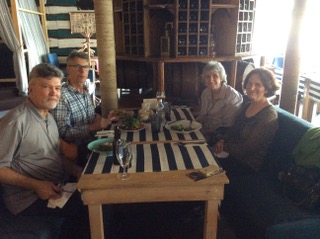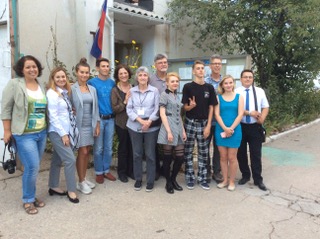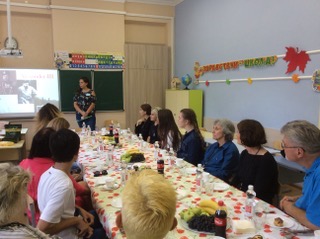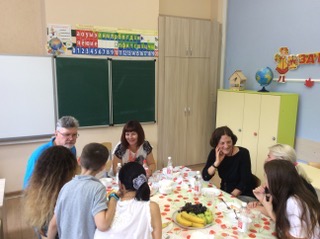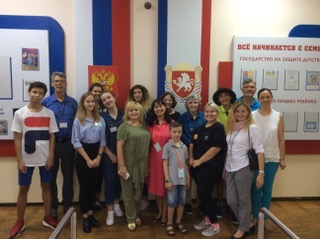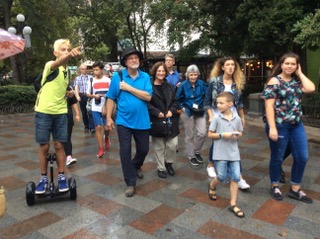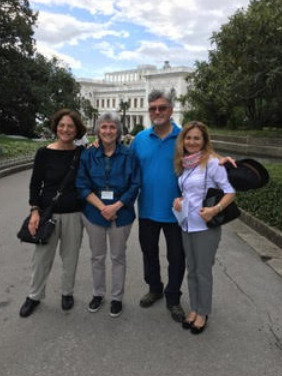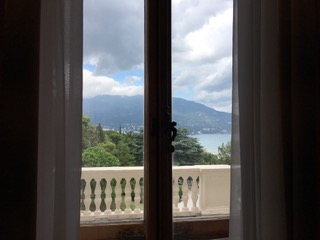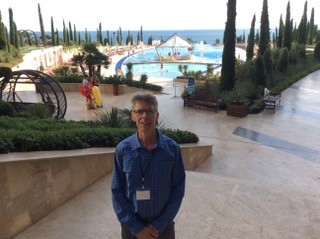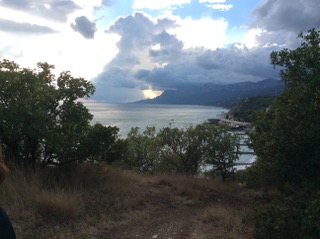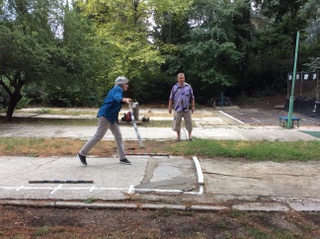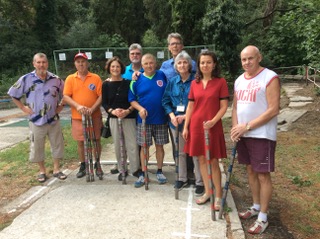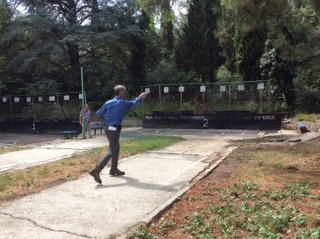Dear CCI Friends,
Our September CCI travelers to Russia are beginning to get the trip accounts written out! The Crimea group, which included trial lawyer Sylvia Demarest from Dallas, anesthesiologist Glenn Rennels from Palo Alto, CA, and Mike and Kathy Metz from Silicon Valley, spent several days in Crimea where they visited Simferopol (the capital), Yalta and Sevastopol where Russia’s Naval Fleet has been stationed since the 1850’s. Enjoy the following foto-journal from our citizen diplomat Sylvia Demarest.

Sharon Tennison
Center for Citizen Initiatives
Dear Friends:
I was in a bit of a rush to get this out—so much so I neglected to mention someone without whom we would have all been lost!! Our good friend Tatyana Bukharina organized all of this, got us where we needed to go, made sure we understood the history of Crimea, and translated everything for us. Tatyana is truly an outstanding historian, a fine scholar, and a wonderful person as well. Without Tatyana the Quad Pod would have been completely lost. My thanks and appreciation to this outstanding historian and patriot of Crimea. The Dallas RMMA volunteers also remember her fondly. Thank you Tatyana!
On the 5th of September, our group split up and traveled to 8 different regions including Yaraslov, Saratov, Perm/Kungur, Krasnodar, Novosibirsk, Ripin, Irkutsk, and Crimea. I was part of the group that went to Crimea. I called the four of us who traveled to Crimea together the “Quad Pod”. Our experience in Crimea was very intense and personal for each of us. The “Pod” included me, Michael and Katherine Metz, and Glenn Rennels. Michael is a retired Silicon Valley executive who had worked for Cisco and Apple, his wife Katherine, an MBA with a background in marketing, Glenn is a retired anesthesiologist, and bringing up the rear with a law degree and a background as a civil trial lawyer was yours truly. We had no idea what we were about to experience.
The plane to Crimea was filled with families and children. As I explained in another report, we saw families and children all over Russia. We also flew over the small villages and fields surrounding Moscow containing the rural homes or “dachas” that Moscovites travel to on weekends and summers. They plant summer gardens, enjoy their “banyas”, or outside saunas, and generally enjoy traditional Russian village life.
As we flew to the Crimean Peninsula we were treated to an aerial view of the new Kerch Strait Bridge. The vehicular portion of the bridge was just completed. Soon there will be train travel over the bridge as well. It is an engineering marvel that is required to operate under very harsh conditions. The bridge includes a crossing over a narrow opening of the Azov Sea. It is the only land connection from Crimea to mainland Russia. This is an enormously important infrastructure project as it will allow both vehicular and train travel between Russia and Crimea.
We landed at a new, very modern international airport in Simferopol which had opened in April of this year. Also under construction was a modern highway from the bridge to the airport and other roads on Crimea. These projects represent a huge investment by Russia in the future of Crimea.
To our great surprise, we were greeted at the airport by a large group of people including several photographers and TV cameras, along with bouquets of roses. We were immediately asked for “interviews”, some of which were live on Crimean TV—and perhaps on Russian TV as well. None of us were expecting any of this. It became a pattern that lasted throughout our stay. Lots of reporters, lots of photographers and TV cameras that followed us everywhere, and everyone wanted an interview.
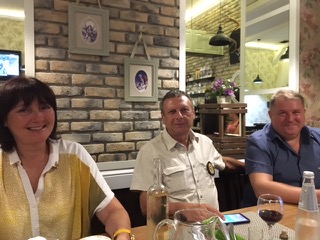 The flowers were soon deposited in a vase on the front desk of the Victoria Hotel in Simferopol. We then went to dinner with members of the local Rotary Club. Yes, the bottle in front of Yuri is vodka—but when I got back to Dallas and was greeted with a welcome home present of a bottle of vodka, I realized I had not consumed even one drop of vodka during the entire trip to Russia!! One reason might have been that towards the end of our stay in Moscow about half of the group contracted an intestinal virus, including me, and we were all still recovering in Crimea.
The flowers were soon deposited in a vase on the front desk of the Victoria Hotel in Simferopol. We then went to dinner with members of the local Rotary Club. Yes, the bottle in front of Yuri is vodka—but when I got back to Dallas and was greeted with a welcome home present of a bottle of vodka, I realized I had not consumed even one drop of vodka during the entire trip to Russia!! One reason might have been that towards the end of our stay in Moscow about half of the group contracted an intestinal virus, including me, and we were all still recovering in Crimea.
Simferopol and Our Visit to The Hope School
Our first visit on the 6th was to the “Hope School”, a school for special needs children supported by both the Russian state and private parties, including the local Rotary Club. It would be an excellent charity for groups in the U.S. to support—depending on what is possible given the fact that Crimea is under U.S. sanctions. We really enjoyed touring this school and meeting the wonderful people who ran the school.
Russia does not have a “People with Disabilities Act”, so many special needs children struggle to find schools that are set up to accommodate their needs. The “Hope School” tries to fill the gap and serves children from all over Crimea. We had a very emotional meeting with the principal who has worked to build this school for 30 years. She talked about small victories for the school such as getting an elevator so the kids in wheel chairs could reach the second floor and finally getting a lift for their bus. It made us all want to adopt this wonderful school.
The school had come up with the idea that the four of us plant 50 trees to build a “Wall of Peace”. Unfortunately, it was raining quite hard. The question came up about whether we should abandon the project. I pointed out that none of us were “made of sugar” so we decided to do our best despite the rain. It involved getting very wet and muddy. We managed to plant 2 of the 50 trees. The boots I was wearing were new and the salesman promised me that they were waterproof. He did not lie. After planting the trees, I stomped around in the puddles of water and got most of the mud off my boots. The “Wall of Peace” would have to be planted by other people. Maybe one day I can visit again and see how much it has grown. I looked for photos of this school visit and tree planting but the only thing I found was a video shown on RT, which included the school visit, the rain, and the tree planting.
https://www.rt.com/news/437800-americans-trip-crimea-diplomacy/
Simferopol and Our Meeting At The Crimean Parliament
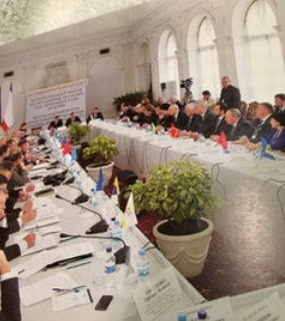 Then we traveled to the Crimean parliament building for a meeting with a large group of the Crimean Parliament, led by Vladimir Konstantinov who is Chairman of the State Council of the Republic of Crimea, along with 8 other ministers and Chairmen of various departments. We were not expecting anything like this. The meeting was held in a very large, formal meeting room where the Parliament usually meets. The four of us, our interpreter, and Tatyana Bukharina are the only ones on one side of the room. Before us is a large stack of cards representing all the people we would be meeting along with a copy of the letter Crimea sent to the UN in response to the UN resolution on the Crimean Referendum. The gravity of this meeting dawned on me. There was media all over with lots of cameras and several TV crews. This is a very formal counsel meeting room with microphones, etc. We were expected to ask questions. We were all in shock so I had to ask the first few questions. Here’s a picture of the room copied from a book.
Then we traveled to the Crimean parliament building for a meeting with a large group of the Crimean Parliament, led by Vladimir Konstantinov who is Chairman of the State Council of the Republic of Crimea, along with 8 other ministers and Chairmen of various departments. We were not expecting anything like this. The meeting was held in a very large, formal meeting room where the Parliament usually meets. The four of us, our interpreter, and Tatyana Bukharina are the only ones on one side of the room. Before us is a large stack of cards representing all the people we would be meeting along with a copy of the letter Crimea sent to the UN in response to the UN resolution on the Crimean Referendum. The gravity of this meeting dawned on me. There was media all over with lots of cameras and several TV crews. This is a very formal counsel meeting room with microphones, etc. We were expected to ask questions. We were all in shock so I had to ask the first few questions. Here’s a picture of the room copied from a book.
Chairman Konstantinov was someone I was familiar with as I had seen him in videos regarding the events in Crimea in 2014 which I had followed at the time. In fact he was one of two people from Crimea to travel to Moscow for the formal annexation ceremony. Here’s a picture from this ceremony. Chairman Konstantinov is on the left. President Putin is in the middle.
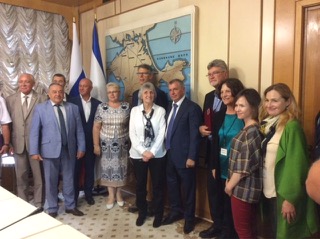 In answers to our questions, the Chairman really opened up and talked about the entire history of this period in 2014 from his perspective. It was quite remarkable and emotional. We were each presented with a copy of his book and a special plaque that we subsequently presented to Sharon Tennison. Mind you this all took place shortly after we had gotten soaked planting trees at the school!! Here’s a picture that was taken after the meeting.
In answers to our questions, the Chairman really opened up and talked about the entire history of this period in 2014 from his perspective. It was quite remarkable and emotional. We were each presented with a copy of his book and a special plaque that we subsequently presented to Sharon Tennison. Mind you this all took place shortly after we had gotten soaked planting trees at the school!! Here’s a picture that was taken after the meeting.
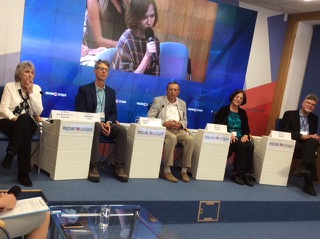
But we weren’t done for the day. Next we were off to attend a “press conference”. This was a very structured affair with lots of journalists in a very formal interview setting. Millions of pictures were taken—here’s one. Once again I just want to point out that all of this was very sudden and none of us were prepared for this level of attention.
We walked out of the Parliament building into a huge group of reporters. Everyone wanted an interview. Naturally, I gave one and probably went a bit beyond what I should have said. For example, I pointed out that under international law Crimean’s had a legitimate right to self determination. Although correct and quite obvious, this statement received a great deal of attention along with my statement that it seemed unlikely that Crimea would return to Ukraine.
I could spend this entire report reviewing the history of how and why Crimea came to rejoin Russia in 2014 but it’s beyond the scope of this report. We decided that the reason we got so much media attention was both because we were granted a meeting with the Crimean Parliament and also because few Americans have traveled to Crimea and even fewer have been willing to listen to the Crimean side of this controversy. We did a lot of listening.
Sevastopol
We next traveled to Yalta where we were to stay for 3 nights. The next morning we traveled to Sevastopol where we met with a large group of people at the Tolstoy Library. Once again this included a large number of reporters, photographers and TV cameras.
We then toured the Sevastopol Harbor where Russia bases its Black Sea fleet. One of their new submarines was anchored there.
Yalta and a short history of Crimea
As I wrote previously, Yalta is an achingly beautiful place as is the whole of Crimea. The history of Crimea is very long—going all the way back to the Greeks including the city of Chersonesus on the Black Sea established in the 6th Century BC.
https://www.telegraph.co.uk/news/worldnews/vladimir-putin/11778965/Putin-promises-protection-for-ancient-Crimea-ruins.html
There is so much here of historic interest. In all, Crimea has been under 5 empires—the Greek, Roman, Mongol/Tartar, Ottoman, Soviet and now Russian.
We drove through the “Valley of Death” made famous by the battle described by Lord Tennyson in his poem— “Charge of the Light Brigade” written during the Battle of Balaclava during the Crimean War of 1854. A good friend’s family moved to the U.S. because they did not want their sons to have to fight in this war. Lord Tennyson watched the battle from a hill over-looking the valley. This entire peninsula has been heavily contested for centuries including WW2. Every inch is hallowed ground.
We next visited School Number 12, an English language school in Yalta. Look at these photos and tell me, do any of the people in these photos look like enemies to you? Yet, every child shown in these pictures is under U.S./EU sanctions which include travel and banking restrictions. Every student we met with could not understand why they could not participate in exchange programs in the U.S. and have the right to travel freely.
We were originally going to have a walk down the promenade and the kids were going to make a presentation at each significant stop allowing them to practice their English—but it was raining! So they made their presentations in this class room.
Roosevelt, Churchill and Stalin–the Livadia Palace and the Mryia resort
It was finally time for some sight seeing including the Livadia Palace where the famous Yalta conference was held in WW2, the Mryia Resort, and an ancient Russian game called “gorodki“. You will have to be satisfied with a few photographs.
I hope I have been able to give you a flavor of this amazing experience.
Your friend in peace,
Sylvia Demarest
Dallas, Texas!!

